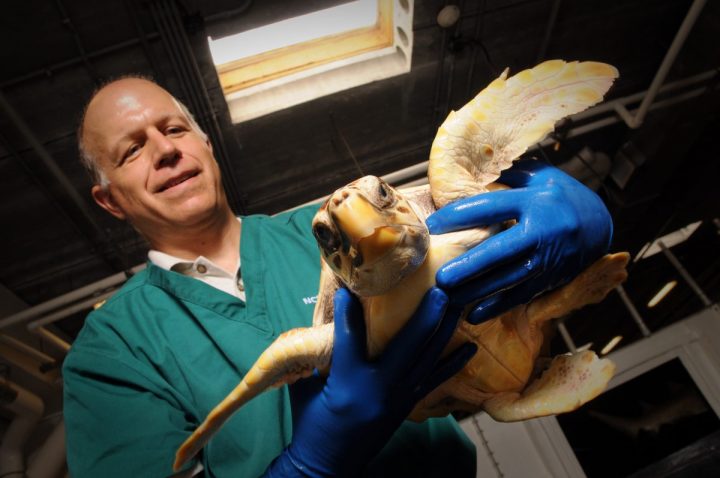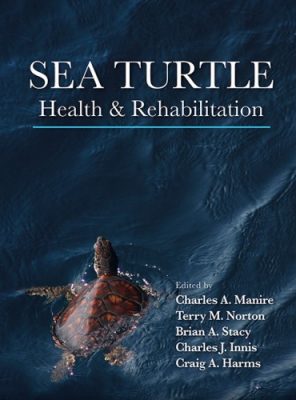
When Dr. Craig Harms returned a call to talk about his book, he was leaving the North Carolina Aquarium at Fort Fisher where he’d been examining sea turtles, and heading to a sea turtle hospital in Surf City, where he not only has been treating turtles but also teaching sea turtle medical treatment to fourth-year veterinary school students from North Carolina State University in Raleigh.
Nothing could have been more appropriate, because Harms, a professor in the Department of Clinical Sciences at N.C. State’s Center for Marine Sciences and Technology, or CMAST, in Morehead City, has helped write, edit and get published in July, “Sea Turtle Health and Rehabilitation,” an academic yet practical tome many feel is destined to become the bible of how to diagnose and treat the reptiles that are beloved by many folks around the world.
Supporter Spotlight
“(It) is the first-ever comprehensive book on sea turtle husbandry, health, medicine and surgery,” according to the publisher, J. Ross Publishing of Plantation, Florida. “This full-color guide presents extensive information for the rescue, evaluation, care and rehabilitation of sick and injured sea turtles at every stage of life.” The publisher calls the work “an essential volume for veterinarians, veterinary students, veterinary technicians, rehabilitators, aquarists, biologists and conservationists who work with sea turtles.”
Harms, who also directs the Marine Health Program at CMAST, isn’t expecting to get rich. The 1,100-page book with 600 full-color photos and illustrations lists for sale at $295, so it’s not likely to be purchased by many of the thousands who in recent years have joined teams that prowl beaches in North Carolina and elsewhere to watch sea turtle nests and help the hatchlings make it to the ocean when those nests “boil,” as it’s called.
But money was never the point.
“It was just something that I and some others thought needed to be done,” Harms said in the phone interview. “And we feel like it turned out very well.”
At one point, the notion had occurred to Harms that he could do it all himself. It didn’t turn out that way, but that’s OK. Others had started first, and asked him to participate.
Supporter Spotlight
It was, he said, “something a lot of us in sea turtle medicine had in the backs of our minds, something that would provide as much as possible of all the good information that we have accumulated. It took three years, and a lot of people were involved.
“It turned out to be well beyond a one-person job. Once we all got started, it just kept growing and growing. It went well beyond what any of us thought it would be. But to the credit of the publisher, they didn’t mind.”

The goal, he said, was simply to “bring together all of that expertise and all of those experiences of people in the field in one place, as a go-to resource for sea turtle medicine.”
The contents include the life history of sea turtles, of course, but also page after page about the complex issues related to the diagnosis and treatment of conditions that are frequently encountered in sea turtles.
There are entire chapters on what the publisher calls “subjects related to sea turtle health and conservation,” such as mortality investigation, fisheries interactions, oil spills and other environmental contamination, pathogens, cold stunning, and harmful algal blooms.
In the past, the sea turtle community relied on scattered chapters and papers to obtain information on care and rehabilitation. It would have been hard to imagine this a decade ago, but the public seems to have fallen in love with these giant reptiles, who, each year, defy the odds and survive in the face of innumerable obstacles.
In Emerald Isle alone – a Carteret County barrier island town with a permanent population of only about 3,000 – there are close to 100 volunteers, some visitors but mostly residents, who spend many summer and fall nights watching nests, digging trenches for hatchlings, moving nests out of tidal zones and into safe places.
Many describe the boiling of a nest and rush of the tiny hatchlings to the sea as close to a religious experience, one perhaps equaled by the sight of the formerly pregnant mother turtle lumbering back into the water after digging the nest on the beach.
Harms gets it, and knows that part of it is the fact that turtles live for decades, are generally all endangered or threatened and remind us of the natural world upon which we have inexorably impinged, to deleterious effects. Maybe we feel that saving sea turtles is saving a part of us?
“They’ve certainly captured the imagination of the public,” Harms said. “They’re reptiles, like snakes, but they don’t seem like reptiles. They have ‘cute’ faces. They make an impression you don’t forget. They seem gentle and friendly. They have big eyes. Their life spans are similar to ours. And their physical presence is, to some degree, symbolic of the health of the marine environment.”
In other words, if these ancient species, these ultimate survivors – loggerheads, Kemp’s ridleys, greenbacks, leatherbacks and the rest, which trace their ancestors back 150 million years – disappear, what does that say about or roles as stewards, and about us in general?
Harms seems somewhat of an unlikely sea turtle guru, given that he grew up in land-locked Iowa. But Iowa also has a great history of spawning conservationists. Think Aldo Leopold, author of “A Sand County Almanac,” and Ding Darling, the legendary editorial cartoonist who inspired millions; he also initiated the Federal Duck Stamp program and designed the first stamp and was appointed by President Franklin D. Roosevelt to be the first head of the U.S. Biological Survey, the forerunner of the U.S. Fish and Wildlife Service.
Harms grew up in Iowa with parents, Ron and Pat, who now live in Morehead City, but were well aware of that culture in Iowa and were always “into” nature.
Sea turtles, of course, were a “foreign concept,” he recalls of his youth, but conservation certainly wasn’t, nor was love of animals. He earned his doctorate in veterinary medicine from Iowa State University in 1989, and his Ph.D. in immunology from N.C. State in 1999. He was a natural for CMAST, which opened its doors on the shore of Bogue Sound in 1997.
In a CMAST article on his work with whales in 2014, he said this about his work with marine mammals and reptiles: “It’s not what I thought I’d be doing back when I went to veterinary school at Iowa State … but relief of animal suffering, collaborating with colleagues who have varied expertise and applying diverse training to novel challenges, is all consistent with that preparation.”
Also consistent is Harms’ participation in writing a book that will help others do the same.
“It was a great team,” he said. “The only downside is the book is so expensive, but there’s really a lot there. It’s comprehensive, and hopefully it will help those in the field now, and those who come later, to save more turtles.”
It’s not always “fun” being a marine veterinarian. He’s had to euthanize turtles, as well as large whales, but has pioneered ways to do that as humanely as possible. But even those duties are meaningful, because the post-mortem necropsies contribute to the knowledge base.
Sea turtle work, though, is especially gratifying, because they are resilient, and the survival rate of injured and sick sea turtles is close to 90 percent.
“Generally, if we can get them past the first week, they will make it,” he said. “And it feels great to succeed. It’s always a challenge, and we take it hard when we have to euthanize one, but the success rate is way higher than it is for many other injured or sick rescued species, such as birds, which are so fragile.”
Part of it, he said, might simply be evolution. Turtles are tough, and not just their shells. “They live a long time,” he said. “They take a long time to die, but they do also take a long time to fully recover.”
He’s optimistic about the survival of the various species, but concedes there is no guarantee. There are so many threats.

Commercial fishermen, aren’t the biggest one, though, at least to Harms’ way of thinking.
“They’re one of many threats,” he said of the turtles getting caught in nets. “But it’s also the most easily identifiable threat. It’s an easy place to point a finger. But there are many other threats.”
They are prone to tumors and soft tissue diseases, as well as viruses, he said. Nutrient-laden stormwater runoff pollutes the waters, and climate change, which is warming the waters, he believes, “is a big threat, although we don’t yet know how big and over what time scale.”
Then, of course, there are plastics in the waters, which the turtles can and often do ingest, blocking their digestive systems. Plastic is a huge problem in the Sargasso Sea, a patch of the Atlantic Ocean where turtles use sargassum mats as nurseries and where hatchlings have food and shelter.
There’s also the persistent problem of lights on the beach during hatching season; hatchlings will head toward the light instead of toward the water, and they are then easy prey for birds and crabs.
But those sea turtle teams, like the close to 100 volunteers in Emerald Isle, are big helpers. Although hatchlings face innumerable threats even once they get to the water, the more hatchlings that make it that far, the more survive.
“I’d never have believed just a few years ago that so many people would be involved in these efforts, and it’s worldwide, not just in the United States,” Harms said. “Wherever there are sea turtles, there are people trying to help save them. And wherever there are sea turtles, there are sea turtle researchers.”
The sea turtle population in North Carolina, Harms said, seems relatively stable, but it’s a mixed bag elsewhere.
“They are survivors, though,” he said. “If we don’t screw up things too bad, they’ll survive.”
Harms is also on the adjunct faculty at the Duke University Marine Laboratory on Pivers Island in Beaufort. He is a past president of the American College of Zoological Medicine and of the International Association for Aquatic Animal Medicine. He has authored or co-authored more than 125 peer-reviewed publications and several book chapters on zoological medicine. In 2011, he received the Stange Award for Meritorious Service by the Iowa State University College of Veterinary Medicine.
Among the others involved in the writing and editing of “Sea Turtle Health and Rehabilitation” are the following:
- Overall editor Dr. Charles Manire, director of research and rehabilitation at the Loggerhead Marinelife Center in Juno Beach, Florida.
- Terry Norton, founder of the Georgia Sea Turtle Center on Jekyll Island, Georgia.
- Brian Stacy, veterinarian for the National Sea Turtle Program under the National Oceanic and Atmospheric Administration, National Marine Fisheries Service, Office of Protected Resources, in Gainesville, Florida.
- Charles Innis, director of animal health at the New England Aquarium in Boston.







